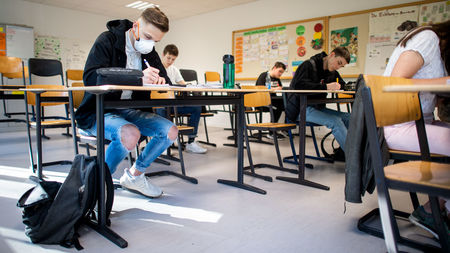Madison’s Return-to-School Plan is Not Worth the Risk
December 15, 2020
Since the initial shutdown last March, Fairfax County Public Schools (FCPS) has kept its students out of the classroom and behind the computer screen. As expected, this all-virtual approach has produced a fair share of challenges throughout its existence, with connection issues and poor student participation still affecting classes today. And while educators and administrators alike have dedicated ample time towards improving online learning, a much greater obstacle remains ahead: safely transitioning over 185 thousand FCPS students back to in-person instruction.
As of now, only a small portion of the Madison student body has returned to the building. This group, consisting of the cross-curricular program and other high-priority groups, only attends school in the building a couple days per week and has been pretty manageable thus far. However, bringing back the remainder of Warhawk Nation will require rigorous health protocols and extensive modifications to everyday student life in order to avoid a viral outbreak.
The current plan has high schoolers who selected in-person learning on their FCPS back-to-school surveys returning on Jan. 26, 2021, just in time for the second semester. With it being nearly impossible to uphold social distancing within Madison’s notoriously overcrowded hallways, students will be divided by last name and will attend classes in-person two days per week.
While this seems sensible in theory, a lot of questions remain unanswered. For starters, how will they ensure that each individual classroom does not exceed a “COVID friendly” capacity? It may be easy to split up the student body as a whole, but the alphabetical distribution of last names will differ from class to class.
Another significant, and possibly more deterring, issue with the current back-to-school plan is the impact it will have on the school’s social atmosphere. One of the key motives for many students hoping to return in January is the desire to socialize with classmates. After all, online learning does not offer ideal circumstances for regular interaction. But how beneficial are in-person classes if you and your friends attend on different days? In a way, this situation may feel more ostracizing than not returning at all. On top of that, some of the peak opportunities for socialization during a typical school day, including lunchtime and traveling between classes, will also undergo drastic changes in an effort to ensure COVID safety.
Teachers who chose to return must also acclimate to the new classroom setting. As the name entails, the concurrent learning model will require them to engage with both their virtual and in-person students simultaneously. To be fair, this strategy is probably the best possible way to accommodate every student’s safety and learning needs. Nonetheless, it is difficult to ignore the potential for major flaws in its execution.
Numerous FCPS employees, students and parents are already expressing concerns on whether or not online classes are providing an adequate education; asking teachers to split their attention between a “live” classroom and a virtual one will just heighten these worries. In other words, the concurrent learning model practically guarantees that one group of students will be ignored at all times. A similar issue of disparity arises with ensuring fair and honest testing. In this situation, though, those who continue with online learning are given the upper hand, as it is much harder for teachers to combat cheating when they are only able to watch their students within the scope of a laptop webcam (unless, of course, the no-cameras-required policy is upheld).
Additionally, there is the possibility that some teachers, due to age and/or underlying medical conditions, will be unwilling to resume in-person instruction. To resolve this issue without altering student schedules, school officials plan on having these teachers broadcast their lessons via Blackboard Collaborate. For those electing to remain virtual, this structure will be perfectly familiar. However, students in the classroom, many of whom prefer to learn in the presence of a teacher, may be disappointed to learn that they will also be attending class on their laptops. An employee will be stationed in the room to offer assistance and enforce school rules, essentially creating a more regulated form of distance learning.
Without a doubt, the COVID-19 pandemic is among the most unprecedented occurrences in recent history; we no longer live in a time where everyday life can simply proceed. Instead, we wage constant debates over how to manage necessary aspects of human existence—educating our children, feeding our families, etc.—while still protecting the health and safety of others. This may not be the school year many of us anticipated, but until we can learn to live in this new “normal” we must adjust ourselves and take the days as they come.



